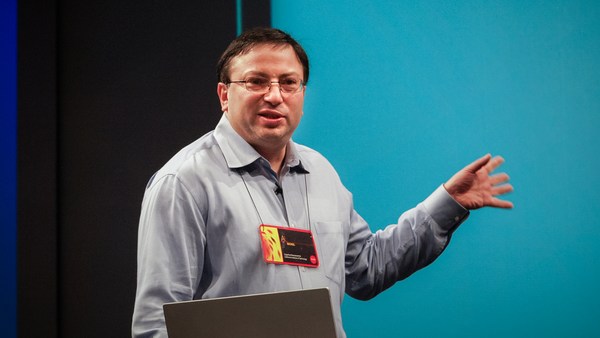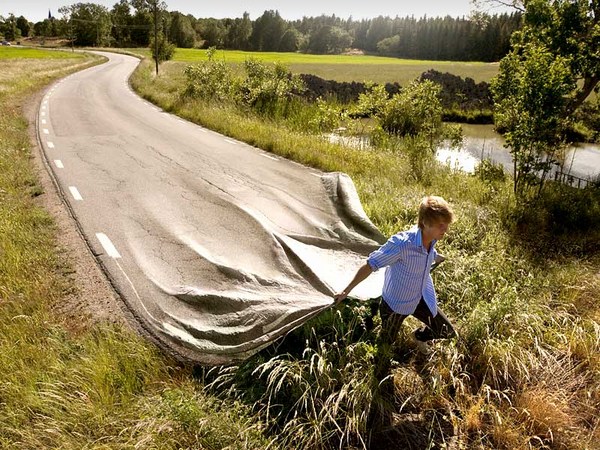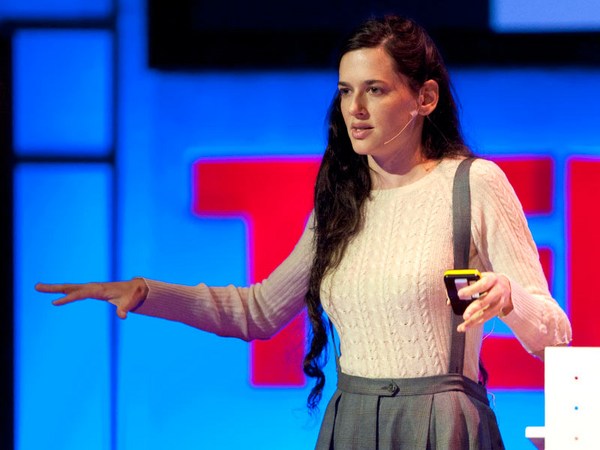I'm a contemporary artist and I show in art galleries and museums. I show a number of photographs and films, but I also make television programs, books and some advertising, all with the same concept. And it's about our fixation with celebrity and celebrity culture, and the importance of the image: celebrity is born of photography.
I'm going to start with how I started with this concept seven years ago, when Princess Diana died. There was a sort of a standstill in Britain the moment of her death, and people decided to mourn her death in a sort of mass way. I was fascinated by this phenomenon, so I wondered: could one erase the image of Diana, actually quite crudely and physically? So, I got a gun and started to shoot at the image of Diana, but I couldn't erase this from my memory and certainly it was not being erased from the public psyche. Momentum was being built. The press wrote about her death in rather, I felt, pornographic ways -- like, "Which bit of artery left which bit of body?" and "How did she die in the back of the car?" -- and I was intrigued by this sort of mass voyeurism, so I made these rather gory images.
I then went on wondering whether I could actually replace her image, so I got a look-alike of Diana and posed her in the right positions and angles and created something that was in, or existed in, the public imagination. So people were wondering: was she going to marry Dodi? Was she in love with him? Was she pregnant? Did she want his baby? Was she pregnant when she died? So I created this image of Diana, Dodi and their imaginary mixed-race child and this image came out, which caused a huge public outcry at the time.
I then went on to make more comments on the media and press imagery, so I started making reference to media imagery -- made it grainy, shot through doorways and so on and so forth -- to titillate the public or the viewer further in terms of trying to make the viewer more aware of their own voyeurism. So, this is an image of Diana looking at Camilla kissing her husband, and this was a sequence of images. And this gets shown in art galleries like this, as a sequence. And similarly with the Di-Dodian baby imagery -- this is another art gallery installation.
I'm particularly interested in how you can't rely on your own perception. This is Jane Smith and Jo Bloggs, for instance, but you think it's Camilla and the Queen, and I'm fascinated how what you think is real isn't necessarily real. And the camera can lie, and it makes it very, very easy with the mass bombardment of imagery to tell untruths. So, I continued to work on this project of how photography seduces us and is more interesting to look at than the actual real subject matter. And at the same time, it removes us from the real subject matter,
and this acts as a sort of titillating thing. So, the photograph becomes this teaser and incites desire and voyeurism; what you can't have, you want more. In the photograph, the real subject doesn't exist so it makes you want that person more. And that is the way, I think, that celebrity magazines work now: the more pictures you see of these celebrities, the more you feel you know them, but you don't know them and you want to know them further.
Of course, the Queen goes to her stud often to watch her horses ... watch her horses. (Laughter). And then I was sort of making imagery. In England there's an expression: "you can't imagine the Queen on the loo." So I'm trying to penetrate that. Well, here is the image.
All this imagery was creating a lot of fuss and I was cited as a disgusting artist. The press were writing about this, giving full pages about how terrible this was. Which I found very interesting that it was going full cycle: I was making comments about the press and about how we know facts and information only by media -- because we don't know the real people; very few of us know the real people -- but it was going back into the press and they were publicizing, effectively, my filthy work. So, these are broadsheets, tabloids, debates were being had all about this work, films were being banned before people had actually had the look at the work, politicians were getting involved -- all sorts of things -- great headlines.
Then suddenly, it started to get on front pages. I was being asked and paid to do front covers. Suddenly I was becoming sort of acceptable, which I found also fascinating. How one moment -- it was disgusting -- journalists would lie to me to get a story or a photograph of me, saying my work was wonderful, and the next minute there were terrible headlines about me. But then this changed suddenly.
I then started to work for magazines and newspapers. This was, for example, an image that went into Tatler. This was another newspaper image. It was an April fool actually, and to this day some people think it's real. I was sitting next to someone at dinner the other day, and they were saying there's this great image of the Queen sitting outside William Hill. They thought it was real.
I was exploring, at the time, the hyperbole of icons -- and Diana and Marilyn -- and the importance of celebrity in our lives. How they wheedle their way into the collective psyche without us even knowing, and how that should happen. I explored with actually dressing up as the celebrities myself. There's me as Diana -- I look like the mass murderer Myra Hindley, I think, in this one. (Laughter). And me as the Queen. I then continued on to make a whole body of work about Marilyn -- the biggest icon of all -- and trying to titillate by shooting through doorways and shutters and so on and so forth, and only showing certain angles to create a reality that, obviously, is completely constructed. This is the look-alike, so the crafting elements of this is completely enormous. She looks nothing like Marilyn, but by the time we've made her up and put wigs and makeup on, she looks exactly like Marilyn, to the extent that her husband couldn't recognize her -- or recognize this look-alike -- in these photographs, which I find quite interesting. So, all this work is getting shown in art galleries. Then I made a book. I was also making a TV series for the BBC at the time. Stills from the TV series went into this book.
But there was a real legal problem because it looks real, but how do you get over that? Because obviously it's making a comment about our culture right now: that we can't tell what's real. How do we know when we're looking at something whether it's real or not? So, from my point of view, it's important to publish it, but at the same time it does cause a confusion -- intentional on my behalf, but problematic for any outlet that I'm working with. So a big disclaimer is put on everything that I do, and I made narratives about all the European or Brit celebrities and comments about our public figures. You know, what does Tony Blair get up to in private with his fashion guru? And also dealing with the perceptions that are put about Bin Laden, Saddam Hussein, the links that were put about pre-Iraq war. And what is going to happen to the monarchy? Because obviously the British public, I think, would prefer William to Charles on the throne.
And it's that wish, or that desire, that I suppose I'm dealing with in my work. I'm not really interested in the celebrity themselves. I'm interested in the perception of the celebrity. And with some look-alikes, they are so good you don't know whether they're real or not.
I did an advertising campaign for Schweppes, which is Coca-Cola, and so that was very interesting in terms of the legalities. It's highly commercial. But it was a difficulty for me -- because this is my artwork; should I do advertising? -- at the time. So I made sure the work was not compromised in any way and that the integrity of the work remained the same. But the meanings changed in the sense that with the logo on, you're closing all the lines of interpretation down to selling a product and that's all you're doing. When you take the logo off, you're opening up the interpretations and making the work inconclusive, opposed to conclusive when you are advertising.
This image is quite interesting, actually, because I think we made it three years ago. And it's Camilla in her wedding dress, which, again, nearly got re-used now, recently prior to her wedding. Tony Blair and Cherie. And again, the legalities -- we had to be very careful. It's obviously a very big commercial company, and so this little, "Shh -- it's not really them," was put on the side of the imagery. And Margaret Thatcher visiting Jeffery Archer in jail.
I then was asked by Selfridges to do a series of windows for them, so I built a sauna bath in one of their windows and created little scenes -- live scenes with look-alikes inside the windows, and the windows were all steamed up. So, it's Tony Blair reading and practicing his speech; I've got them doing yoga inside there with Carole Caplin; Sven making out with Ulrika Jonsson, who he was having an affair with at that time. This was a huge success for them because the imagery got shown in the press the day after in every single newspaper, broadsheets and tabloids. It was a bit of a road stopper, which was problematic because the police kept on trying to clear away the crowds, but huge fun -- it was great for me to do a performance. Also, people were taking photographs of this, so it was being texted around the world extremely quickly, all this imagery. And the press were interviewing, and I was signing my book. (Laughter).
Further imagery. I'm making a new book now with Taschen that I'm working on really for a sort of global market -- my previous book was only for the U.K. market -- that I suppose it could be called humorous. I suppose I come from a sort of non-humorous background with serious intent, and then suddenly my work is funny. And I think it doesn't really matter that my work is considered humorous, in a way; I think it's a way in for me to deal with the importance of imagery and how we read all our information through imagery. It's an extremely fast way of getting information. It's extremely difficult if it's constructed correctly, and there are techniques of constructing iconic imagery.
This image, for example, is sort of spot-on because it exactly sums up what Elton may be doing in private, and also what might be happening with Saddam Hussein, and George Bush reading the Koran upside-down. For example, George Bush target practice -- shooting at Bin Laden and Michael Moore. And then you change the photograph he's shooting at, and it suddenly becomes rather grim and maybe less accessible. (Laughter). Tony Blair being used as a mounting block, and Rumsfeld and Bush laughing with some Abu Ghraib photos behind, and the seriousness, or the intellect, of Bush. And also, commenting on the behind the scenes -- well, as we know now -- what goes on in prisons. And in fact, George Bush and Tony Blair are having great fun during all of this.
And really commenting, you know, based on the perception we have of the celebrities. What Jack Nicholson might be up to in his celebrity life, and the fact that he tried to ... he had a bit of road rage and golf-clubbed a driver the other day. I mean, it's extremely difficult to find these look-alikes, so I'm constantly going up to people in the street and trying to ask people to come and be in one of my photographs or films. And sometimes asking the real celebrity, mistaking them for someone who just looks like the real person, which is highly embarrassing. (Laughter).
I've also been working with The Guardian on a topical basis -- a page a week in their newspaper -- which has been very interesting, working topically. So, Jamie Oliver and school dinners; Bush and Blair having difficulty getting alongside Muslim culture; the whole of the hunting issue, and the royal family refusing to stop hunting; and the tsunami issues; and obviously Harry; Blair's views on Gordon Brown, which I find very interesting; Condi and Bush. This image I've decided to show having a reservation about it. I made it a year ago. And just how meanings change, and there were a terrible thing that has happened, but the fear is lurking around in our minds prior to that. That's why this image was made one year ago, and what it means today. So, I'll leave you with these clips to have a look. (Music)
Chris Anderson: Thank you.





